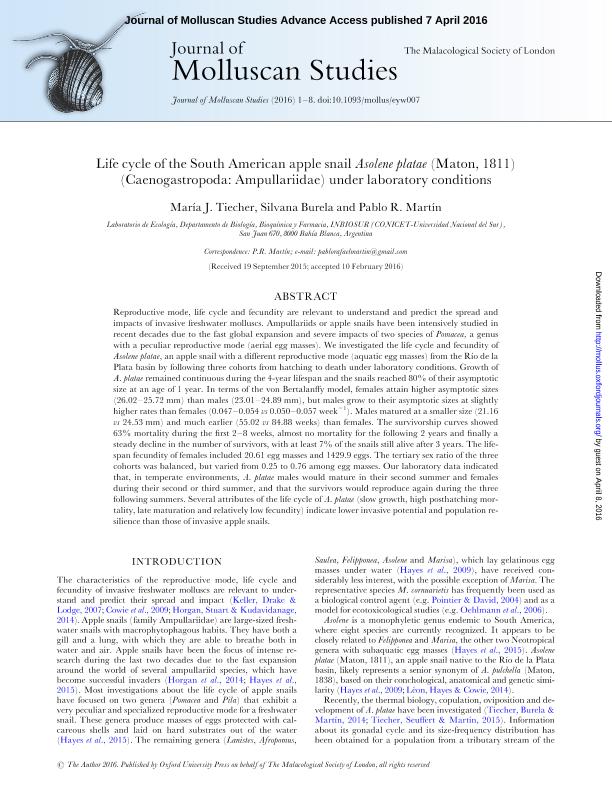Mostrar el registro sencillo del ítem
dc.contributor.author
Tiecher, María José

dc.contributor.author
Burela, Silvana

dc.contributor.author
Martín, Pablo Rafael

dc.date.available
2018-04-03T18:51:02Z
dc.date.issued
2016-04
dc.identifier.citation
Tiecher, María José; Burela, Silvana; Martín, Pablo Rafael; Life cycle of the South American apple snail Asolene platae (Maton, 1811) (Caenogastropoda: Ampullariidae) under laboratory condition; Oxford University Press; Journal of Molluscan Studies; 82; 3; 4-2016; 432-439
dc.identifier.issn
0260-1230
dc.identifier.uri
http://hdl.handle.net/11336/40536
dc.description.abstract
Reproductive mode, life cycle and fecundity are relevant to understand and predict the spread and impacts of invasive freshwater molluscs. Ampullariids or apple snails have been intensively studied in recent decades due to the fast global expansion and severe impacts of two species of Pomacea, a genus with a peculiar reproductive mode (aerial egg masses). We investigated the life cycle and fecundity of Asolene platae, an apple snail with a different reproductive mode (aquatic egg masses) from the Río de la Plata basin by following three cohorts from hatching to death under laboratory conditions. Growth of A. platae remained continuous during the 4-year lifespan and the snails reached 80% of their asymptotic size at an age of 1 year. In terms of the von Bertalanffy model, females attain higher asymptotic sizes (26.02–25.72 mm) than males (23.01–24.89 mm), but males grow to their asymptotic sizes at slightly higher rates than females (0.047–0.054 vs 0.050–0.057 week−1). Males matured at a smaller size (21.16 vs 24.53 mm) and much earlier (55.02 vs 84.88 weeks) than females. The survivorship curves showed 63% mortality during the first 2–8 weeks, almost no mortality for the following 2 years and finally a steady decline in the number of survivors, with at least 7% of the snails still alive after 3 years. The lifespan fecundity of females included 20.61 egg masses and 1429.9 eggs. The tertiary sex ratio of the three cohorts was balanced, but varied from 0.25 to 0.76 among egg masses. Our laboratory data indicated that, in temperate environments, A. platae males would mature in their second summer and females during their second or third summer, and that the survivors would reproduce again during the three following summers. Several attributes of the life cycle of A. platae (slow growth, high posthatching mortality, late maturation and relatively low fecundity) indicate lower invasive potential and population resilience than those of invasive apple snails.
dc.format
application/pdf
dc.language.iso
eng
dc.publisher
Oxford University Press

dc.rights
info:eu-repo/semantics/openAccess
dc.rights.uri
https://creativecommons.org/licenses/by-nc-sa/2.5/ar/
dc.subject
Growth
dc.subject
Reproductive Activity
dc.subject
Survivorship
dc.subject
Sex Ratio
dc.subject.classification
Otras Ciencias Biológicas

dc.subject.classification
Ciencias Biológicas

dc.subject.classification
CIENCIAS NATURALES Y EXACTAS

dc.title
Life cycle of the South American apple snail Asolene platae (Maton, 1811) (Caenogastropoda: Ampullariidae) under laboratory condition
dc.type
info:eu-repo/semantics/article
dc.type
info:ar-repo/semantics/artículo
dc.type
info:eu-repo/semantics/publishedVersion
dc.date.updated
2018-03-28T16:59:06Z
dc.journal.volume
82
dc.journal.number
3
dc.journal.pagination
432-439
dc.journal.pais
Reino Unido

dc.journal.ciudad
Oxford
dc.description.fil
Fil: Tiecher, María José. Consejo Nacional de Investigaciones Científicas y Técnicas. Centro Científico Tecnológico Conicet - Bahía Blanca. Instituto de Ciencias Biológicas y Biomédicas del Sur. Universidad Nacional del Sur. Departamento de Biología, Bioquímica y Farmacia. Instituto de Ciencias Biológicas y Biomédicas del Sur; Argentina
dc.description.fil
Fil: Burela, Silvana. Consejo Nacional de Investigaciones Científicas y Técnicas. Centro Científico Tecnológico Conicet - Bahía Blanca. Instituto de Ciencias Biológicas y Biomédicas del Sur. Universidad Nacional del Sur. Departamento de Biología, Bioquímica y Farmacia. Instituto de Ciencias Biológicas y Biomédicas del Sur; Argentina
dc.description.fil
Fil: Martín, Pablo Rafael. Consejo Nacional de Investigaciones Científicas y Técnicas. Centro Científico Tecnológico Conicet - Bahía Blanca. Instituto de Ciencias Biológicas y Biomédicas del Sur. Universidad Nacional del Sur. Departamento de Biología, Bioquímica y Farmacia. Instituto de Ciencias Biológicas y Biomédicas del Sur; Argentina
dc.journal.title
Journal of Molluscan Studies

dc.relation.alternativeid
info:eu-repo/semantics/altIdentifier/doi/http://dx.doi.org/10.1093/mollus/eyw007
dc.relation.alternativeid
info:eu-repo/semantics/altIdentifier/url/https://academic.oup.com/mollus/article/82/3/432/1751899
Archivos asociados
